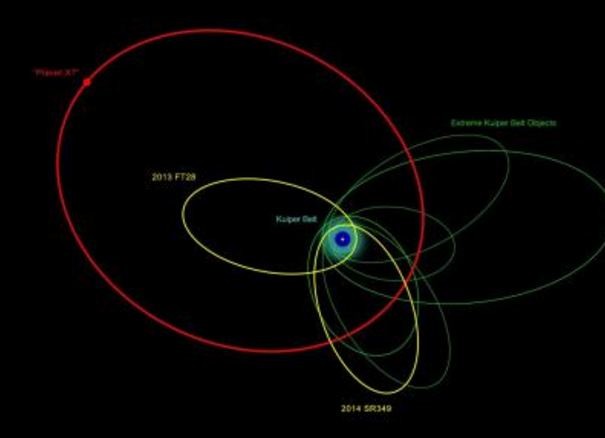Scientists have observed several never-before-seen objects at extreme distances from the Sun in the race to discover a ninth planet (also called Planet X) in our solar system.
Carnegie's Scott Sheppard and Chadwick Trujillo of Northern Arizona University said the more objects found at extreme distances, the better the chance of constraining the location of the ninth planet. They've submitted their latest discoveries to the International Astronomical Union's Minor Planet Center for official designations.
In 2014, Sheppard and Trujillo first predicted this ninth planet exists far beyond Pluto. The placement and orbits of small, extreme trans-Neptunian objects (TNOs) can help narrow down the size and distance from the Sun of the predicted ninth planet. This because the ninth planet's gravity influences the movements of the smaller objects that are far beyond Neptune.
The objects are called TNOs because their orbits around the Sun are greater than Neptune's.
Sheppard and Trujillo in 2014 announced the discovery of 2012 VP113 (nicknamed "Biden"), the most-distant known orbit in our solar system. At this time, Sheppard and Trujillo also noticed the handful of known extreme TNOs all cluster with similar orbital angles.
This led them to predict the existence of a planet at more than 200 times our distance from the Sun. Its mass, ranging in possibility from several Earths to a Neptune equivalent, is shepherding these smaller objects into similar types of orbits.
Some have called this Planet X or Planet 9. Further work since 2014 showed that this massive ninth planet likely exists by further constraining its possible properties.
The other new objects they've submitted to the Minor Planet Center for designation include 2014 SR349, which adds to the class of the rare extreme trans-Neptunian objects. It exhibits similar orbital characteristics to the previously known extreme bodies whose positions and movements led Sheppard and Trujillo to initially propose the influence of Planet X.
Another new extreme object they found, 2013 FT28, has some characteristics similar to the other extreme objects but also some differences.
Another discovery, 2014 FE72, is the first distant Oort Cloud object found with an orbit entirely beyond Neptune.
As for the alleged Planet X, analysis of "neighboring" small body orbits suggest it 's several times more massive than the Earth, possibly as much as 15 times, and at the closest point of its extremely stretched, oblong orbit it is at least 200 times farther away from the Sun than Earth. This is over 5 times more distant than Pluto.
"Objects found far beyond Neptune hold the key to unlocking our Solar System's origins and evolution," said Sheppard.
"Though we believe there are thousands of these small objects, we haven't found very many of them yet, because they are so far away. The smaller objects can lead us to the much bigger planet we think exists out there. The more we discover, the better we will be able to understand what is going on in the outer Solar System."
Sheppard and Trujillo, along with David Tholen of the University of Hawaii, are conducting the largest, deepest survey for objects beyond Neptune and the Kuiper Belt and have covered nearly 10 percent of the sky to date using some of the largest and most advanced telescopes and cameras in the world, such as the Dark Energy Camera on the NOAO 4-meter Blanco telescope in Chile and the Japanese Hyper Suprime Camera on the 8-meter Subaru telescope in Hawaii.



























